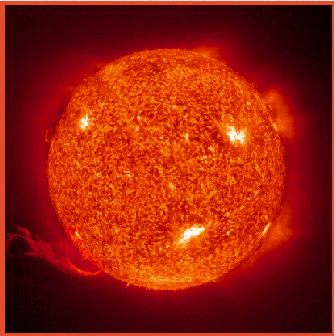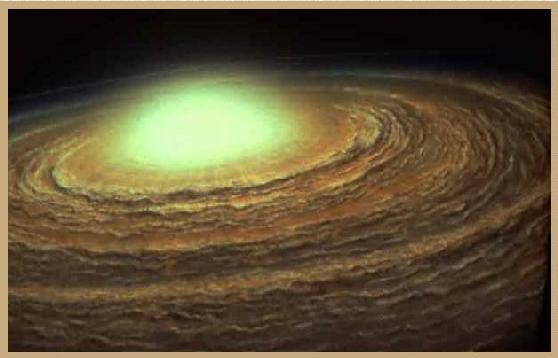 Lesson 1:
Lesson 1:
 Ecology of the System
Ecology of the System
|
 1.2
1.2
 The Age of the Solar System
The Age of the Solar System

|

Figure 1.2.1 The Sun in x-rays.
|
Two fundamental discoveries about our world are among the greatest contributions to human
thought: The age of the solar system and the energy-source of the Sun. The two are related,
because only the energy of fusion (whereby mass is made into energy) could have fueled the
Sun for as long as it has warmed our home planet.
The discovery of the energy-source of the Sun - fusion of hydrogen nuclei (= protons) to
make helium nuclei (= alpha particles) - owes much to the discovery of radioactivity (by
Antoine Becquerel and the wife-and-husband team Marie and Pierre Curie), to the discovery
of the proton and of the mutability of atomic nuclei (by Ernest Rutherford), and to the
realization that mass itself is a manifestation of energy (by Albert Einstein). Together,
these discoveries are less than a century old. The Sun as a nuclear furnace is only
reasonably well understood since the 1930s.
The discovery of "deep time" goes back at least to the speculations of the German
philosopher Immanuel Kant (1724-1804), the French mathematician and astronomer Pierre Simon
Laplace (1749-1827) and the Scottish naturalist James Hutton (1726-1797). Kant and Laplace
proposed the "nebular hypothesis" of the origin of the solar system, whereby the planets
formed from condensation out of matter orbiting the early Sun. Obviously such an origin
implies enormous amounts of time. Hutton proposed immensely long time spans to explain how
the observable rates of erosion and deposition, and the ongoing volcanic activity, can be
made responsible for the origin of great valleys, thick sediment sequences and mountain
ranges, and all other features of Earth's surface.

|

Figure 1.2.2 Artist's redition of the solar nebula.
|
Early estimates of actual time spans, in the 19th century, ran to 100 million years and
more. Of course, such estimates did not sit well with those who reckoned geologic time by
studying the genealogies given in the Old Testament, which summarizes the history of the
Jewish people. (In the 1650s Archbishop James Ussher of Ireland, one of the more careful
and distinguished scholars of time, put the beginning of Earth at 4004 B.C., a surprisingly
precise estimate.) An estimate of 100 million years or more also proved unacceptable to the
famous British physicist William Thomson (1824-1907), better known as Lord Kelvin. Kelvin,
then the world's expert on thermodynamics, calculated (in the late 1800s) an age of 20 to
40 million years for the Earth, assuming that the planet cooled from an originally molten
condition. This age seemed reasonable, considering that the Sun should have burned out if
it were much older, and that a planet should be younger than its star.
The discoveries by Becquerel and the Curies not only set the stage for the finding that
mass equals energy, but also led straight into the field of radioactive dating.
The principle of radioactive dating is simple: The content of radioactive elements in a
given material decreases with time, as the element gives off radiation (alpha, beta or
gamma) and thereby changes its nature, that is, turns into a "daughter" element. By
measuring the amount of a radioactive element and its daughter element (or elements) an
estimate can be made about how much of the original amount of radioactive element remains.
From the rate of decay (measured by determining the activity) a "half-life" is estimated
for each radioactive element. This is the time it takes for one-half of the element in
question to "decay" into a daughter element. By using different decay series with different
half-lives (uranium-238 to lead-206; uranium-235 to lead-207; thorium-232 to lead-208;
rubidium-87 to strontium-87; potassium-40 to argon-40) the estimates can be double-checked
and greatly refined.
The age of the solar system, derived from the study of meteorites (thought to be the oldest
accessible material around) is near 5 billion years; that of the Earth is taken as 4.6
billion years. The oldest rocks on Earth are dated as 3.8 billion years. These rocks
already have signs of advanced life forms, as chemical fossils, mineral matter that
has odd properties thought to result from life processes.
|





















